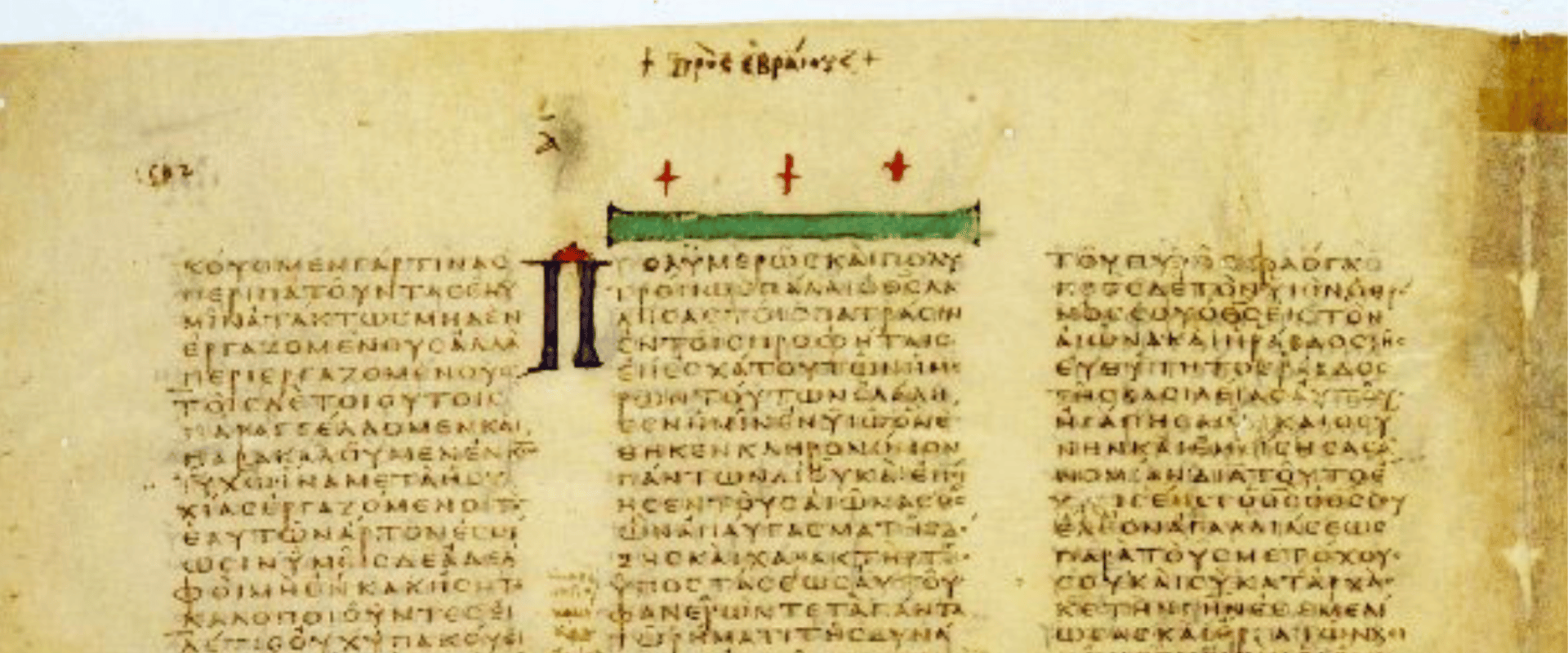How Old Is the Bible & How Many Years did It Take to Write the Bible?

Written by Marko Marina, Ph.D.
Author | Historian | BE Contributor
Verified! See our editorial guidelines
Disclaimer: The views and opinions expressed in this article belong to the author and do not necessarily match my own. - Dr. Bart D. Ehrman
How old is the Bible? The infamous character Leigh Teabing makes one of the most memorable statements from Dan Brown’s novel, “Da Vinci Code.” He said, “The Bible did not arrive by fax from heaven.” Although the book, “Da Vinci Code,” contains several historical inaccuracies, this particular statement is correct.
In the following post, I explore when the Bible was created and how old the King James Bible is by examining modern scholarship.
To learn more about the Gospels, an essential part of the Bible, you should attend a free 50 minutes webinar with Bart Ehrman. As a distinguished scholar of early Christianity, Bart provides important information about the Gospels and their authors.

The Bible is A Collection of Books
How many years did it take to write the Bible? This is a question I often encounter in my classroom. It’s crucial to understand the Bible is not a single book but a compilation of many texts written over an extended period.
Consequently, the precise dating of some books of the Bible presents a challenge for modern scholars.
In my country, Croatia, where Roman Catholicism holds a dominant position, the canon of the Bible comprises 46 books from the Old Testament (Hebrew Bible) and 27 books from the New Testament. In the USA, the mainstream Bible includes 39 books of the Old Testament.
Both ends of the timetable are essential to understand the complexity of creating the Bible. I begin by exploring the oldest parts of the Bible and examining the earliest collections and the impact of the King James Version.
When Was the Bible Created? LEt's Start at the Beginning
According to the consensus among scholars, the oldest parts of the Bible can be found in specific layers of Isaiah (1 – 31) and Amos (2, 6 -9, 10). In a compelling study titled “The Book of Amos in Emergent Judah,” Jason Radine demonstrates that the earliest stage of the Book of Amos was completed after the fall of the northern kingdom of Israel to the Neo-Assyrian empire in 722 BCE.
He concludes: “A time from around the end of the eighth century to the early seventh century is probably the best choice for the initial composition.”
On the other end of the spectrum, to reach one of the youngest books of the Bible, we must traverse through eight centuries and numerous cultural changes, eventually arriving at the time of the Roman Empire.
The Book of Revelation, probably written at the end of the 1st century CE, is a testament to this journey. Revelation captivates readers with its imagery and symbolic language, vividly describing visions of the end times, the final judgment, and the ultimate triumph of God over evil.
As Bart emphasizes in his recent study “Armageddon: What the Bible Really Says About the End, the Book of Revelation remains “the most mystifying book of the Bible.”
How old is the Bible? As you can see, more than seven centuries stand between the oldest and the youngest books of the Bible.
The Oldest Bible Manuscripts
Moreover, the earliest surviving and almost complete manuscripts of the Bible date to the 4th century C.E.
They are known as the four great uncial codices of the Bible, and they contain the majority of the Old and the New Testament books:
a. Codex Vaticanus – depicted in the picture below
b. Codex Sinaiticus
c. Codex Alexandrinus
d. Codex Ephraemi Rescriptus

The Bible in the Classroom
Whenever I discuss these ancient codices in my classroom, students are particularly intrigued by two fascinating facts.
Firstly, these codices are written without regular gaps between words and solely with majuscule letters, making the reading process challenging and demanding.
Secondly, what surprises many is that two of these ancient codices, Codex Sinaiticus and Codex Alexandrinus, contain books later rejected from the biblical canon (e.g., Shepherd of Hermans and 1 Clement).
These intriguing details shed light on the complexity of ancient manuscripts and the historical evolution of the biblical canon, offering students a deeper appreciation for the meticulous work of scribes and the ever-evolving process of assembling the Biblical texts we know today.
In other words, the development of the Bible is a testament to the richness of human history. Its path during the subsequent centuries only proves that point.
The Bible in the Medieval Period: From Jerome to King James Version
During the medieval period in the Western world, one Latin translation stood out as the predominant version of the Bible – the Vulgate.
This influential translation was the work of none other than St. Jerome, a prominent church father and theologian from the 4th century C.E. Within the Roman Catholic Church, the Vulgate gained official approval and held a position of significance.
However, with the dawn of the Reformation and the emergence of various religious movements in the 15th and 16th centuries, the Vulgate began to lose its primacy.
Notably, this process was initiated by the renowned humanist and theologian Erasmus of Rotterdam (1466-1536). His critical scholarship and efforts to promote the study of original biblical texts challenged the longstanding authority of the Vulgate within scholarly and religious circles.
Erasmus’s Latin translation of the New Testament proved dangerous in the eyes of the Catholic Church.
Why? Well, it diverged from the standard edition of Jerome’s Vulgate.
Let me give you an example from the Gospel of Matthew.
Jerome's Vulgate (Mt 4, 17) | Erasmus’S Translation (Mt 4, 17) |
|---|---|
From that time Jesus began to preach, and to say: Do penance, for the kingdom of heaven is at hand. | From that time Jesus began to preach, and to say: Be penitent, for the kingdom of heaven is at hand. |
Catholic officials interpreted this as an attack on the importance of the Sacrament of Penance. This sacrament was (and still is) an essential part of the belief system of the Catholic Church.
How Old is the King James Bible?
Despite the opposition from the Catholic Church, the influence of Erasmus’s work spread across Europe as the Western world witnessed the Reformation Era and the permanent changes in its religious landscape.
Another significant transitional stage in the process of creating the Bible occurred with the commissioning of the King James Bible. This iconic translation was initiated by King James I of England in 1604 and completed in 1611.
The motivation behind this endeavor was the King’s desire for a new, unified, and accurate translation of the Bible, aiming to replace the various existing English versions that were in use at that time.
From a modern scholarship perspective, it is evident that the King James Bible does include several episodes from Jesus’s life that were not part of the original Bible texts. A great example, as discussed by Bart in a blog article, is the well-known account of Jesus and the Woman Taken in Adultery.
This specific passage, found in John 7:53-8:11, narrates the encounter between Jesus and a woman caught in adultery. While it is a beloved and powerful story, many scholars agree that this passage was not present in the earliest manuscripts of the New Testament and was likely added later.
If you want to know more about other examples of stories that were not originally in the Bible, read Bart’s bestseller “Misquoting Jesus: The Story Behind Who Changed the Bible and Why?”.
The King James Version & the English Language
Despite these shortcomings, King James Version is one of the most influential and widely-read English translations of the Bible. Moreover, it played a crucial role in the development of the English language.
David Crystal’s research in “Begat: The King James Bible and the English Language” highlights a fascinating fact – an estimated 257 idioms in modern English can be traced back to the King James Bible. This extensive influence on the English language is unparalleled!
Crystal points out that “No other single source has provided the language with so many idiomatic expressions.”
If you guess which English author comes second in this list, I’ll buy you dinner when you come to Croatia!
Conclusion: How Old is the Bible & the King james Version?
The Bible is an ancient collection of different texts, with its oldest parts dating back over 2700 years.
The earliest surviving collections of the Christian Bible originated in the 4th century C.E. The Bible’s journey through history and its enduring influence makes it one of the most captivating literary works in the world.
As for the King James Version, it was completed in 1611.
If you want to experience that journey with a renowned scholar of Christianity, I invite you to join Bart’s excellent course, “The Unknown Gospels.” Click the link below.

